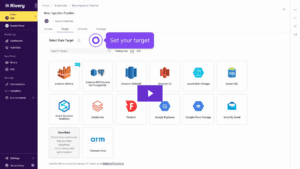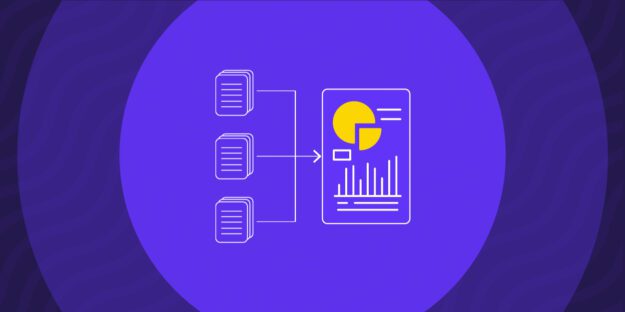With the influx of data and data storage across multiple platforms, businesses today need faster and better tools to collect, manage, and migrate that data, regardless of size. The ETL Tools Market Research Report shows that from 2022 up to 2030, the ETL market will grow each year exponentially.
The right ETL tool will allow data engineers to stop worrying about human errors when working with big batches of data. Namely, before, data engineers had to manually build and manage data pipelines, which made them prone to mistakes with the flow of data. That also led to piled-up work, as keeping up with the changes proved too much to handle.
So, to simplify this process—starting from extraction, transformation, and then loading the data in the needed data warehouse—ETL tools took charge. All small or large businesses that work with data integration and data management as part of their services must utilize the right ETL tools to process the data faster and thus improve their business efficiency.
What Are ETL Tools?
ETL tools—Extract, Load, Transform tools—are essential for data management. They collect, read, and migrate data from various sources into a target data store.
These tools efficiently handle data operations, including filtering, joining, merging, reformatting, and aggregating, allowing for seamless integration and analysis. Additionally, ETL tools can detect changes in data streams, eliminating the need to refresh the entire data set and ensuring efficient data processing.
Most of these tools are automated to make a company’s daily workflow function more effectively and can also be run in either real-time or in batch loads.
Since data comes from different sources, such as unstructured, semi-structured, or legacy system data, ETL tools are used for pulling and transforming this data into a usable format for analysis. Of course, not all ETL tools can work with every kind of data format—many of the best ETL tools offer broad support for all data sources and formats.
We’ve created a detailed ETL tool list with the best 13 ETL tools for users in 2024.
13 Best ETL Tools For 2024
1. Rivery
Rivery is a complete SaaS ETL platform that enables you to build end-to-end pipelines and offers its users many features that save time and energy. With over 200 connectors that come pre-built, a native transformation and orchestration layer, this platform provides centralized control over the entire data workflow from source to target.
It has a flexible and easy-to-use ETL tool that performs all its significant functions such as schema creation and incremental load management in an automated process. The software can even do reverse ETL, transferring data from the data warehouse back to the business tools users employ.
Through Rivery’s API interface, data engineers can remotely edit and manage the data pipeline and make any necessary changes. The platform’s ETL tools can easily manage the day-to-day workflow and data analysis of a business of any size.
Rivery comes with three plans, the price of which varies depending on the size of the data being replicated or the API sync frequency. The best part is that you can try out the software with the free trial offered for both the starter and professional packages. With numerous features and tools, this platform was built to service any business need.
- Over 200 pre-build native connectors
- Users can configure their own custom connectors
- Easy to learn with SQL & Python transformations
- Free trial available
- Kit Hub filled with pre-built data workflow templates
- Has no focus on real-time streaming
2. Integrate.io
A cloud-sourced data service provider, Integrate.io, has various features its users can utilize. These include ETL tools, API generation, and data warehouse insights. It also comes with hundreds of connectors capable of performing routine data service within minutes.
While these connectors can fully complete most data processes, companies may need to have their development team make and input the codes to resolve possible issues.
- 14 days free trial
- Has no-code solutions
- A long list of features, including ETL, ELT, and Reverse ETL handling
- Doesn’t support popular destinations such as Databricks
- It needs more skilled users
3. Oracle Data Integration
Oracle is a robust platform designed to take on the role of data integration and management processes for large companies and enterprises. Their software is quite capable of handling large data batches and can perform parallel tasks simultaneously. To do this, it uses its other solutions: Oracle Golden Gate and Oracle Enterprise Manager.
Unfortunately, Oracle Data Integration is not the easiest ETL tool to implement and may require better-trained data engineers to maintain the platform.
- A step-by-step guide on using the product is provided
- Easy and quick integration of data
- Can handle big batches of data
- Not the simplest ETL tool to work with
- The price may be too high
4. Airbyte
Airbyte is an open-source data integration platform designed to facilitate the process of moving and syncing data between different sources and destinations. It offers connectors to various data sources and destinations, enabling users to easily set up data pipelines for extracting, transforming, and loading (ETL) data. Airbyte also offers a cloud product called Airbyte Cloud which was introduced in beta as of March 2023 which is managed by Airbyte but includes multiple limits.
- Open-Source if you choose to build in the build vs buy decision.
- Easy and quick integration of data
- Airbyte cloud is limited
- Airbyte isn’t the best with CDC.
5. Fivetran
Fivetran is an ETL tool with an easy-to-use software interface capable of keeping up with all the new updates from API. The software platform specializes in assisting enterprises and large businesses with data management. Other features Fivetran offers users are round-the-clock support, security, and database duplication.
One of the downsides to using Fivetran is that custom options for connectors are a bit limited, so users must carefully research what they can and can’t customize.
- A long list of data connectors
- Predefined schemas for replicated apps
- Robust API
- Limited orchestration abilities
- Doesn’t offer fine grain control over the replicated data
6. Talend
Talend is an open-source platform used primarily for building data pipelines. It comes with a graphical user interface that data engineers can use to easily build connectors with Excel, Oracle, Dropbox, and Microsoft Dynamics. It’s flexible and can be used either on-premises or on cloud-based platforms.
Talend offers a free version that has fewer features than the complete one. If you’re planning on going professional, note that the price of the pro package is more affordable for enterprises than for smaller businesses.
- Open-sourced ETL tool with high security
- Lots of data quality features
- Solid free version with the chance to upgrade
- Steep learning curve
- Not designed as a cloud platform to begin with
7. Pentaho
Pentaho is another open-source platform used for data integration processes. Aside from this, it has additional features such as data cleansing and formatting and a very simplistic interface. Additionally, you can use it to store data. This ETL tool can work with structured and unstructured data.
Similar to Talend, Pentaho has 2 versions: a Community version (an open-source platform you can use for free) and an Enterprise version (paid license).
- Can work with structured and unstructured data
- Easy to work with
- It can be integrated with almost any source
- The design interface is lacking
- Not designed for the cloud
8. Informatica
Informatica is a data management platform that is mainly used by large businesses for the way it streamlines data pipelines. It has many APIs and can extract and load data from various sources.
Regardless of how user-friendly its interface is, it’s still best handled by data engineers that went through dedicated training. Moreover, businesses that want to process large amounts of data will require computing equipment and software that is strong enough to handle this ETL tool.
- It can be connected to many databases
- Developing and maintaining code is simple
- Many features
- It doesn’t work with macOS
- Requires a lot of memory
9. Skyvia
Skyvia is an open-source software platform requiring no coding to accomplish simple tasks. This tool allows users to customize various features, such as their data sync. The platform also lets you import your data onto cloud-based databases and allows CVS import and export commands.
Its drawback is that restoring data can be complex, while creating backup data may take a while.
- Moving data is simple and quick
- It has pre-made data integration templates
- It gives detailed error logs
- The sync process can take a lot of time
- Restoring data is also difficult
10. AWS Glue
This cloud-based service comes with tools and features meant for smoothing out the data integration processes for data in AWS. Data engineers and others not well-versed in ETL or clouds can use its user-friendly interface. Still, AWS Glue is suitable for companies that prefer to use SQL. It’s also capable of running any ETL process on a pre-selected schedule.
One downside is its compatibility—it’s made for AWS products, so it’s incompatible with any other technology.
- Supports integration with several databases
- Has automatic schema discovery
- Requires previous knowledge to use it
- No SaaS app integration for most apps
11. Azure Data Factory
Azure Data Factory is a serverless hybrid data integration service that can be built to match the needs of any business that wishes to use it on Azure. It can automatically scale the data processes required to meet the company’s demands and comes with two graphical user interfaces: one with a code and one without. This makes it usable to both end users and a data team.
While this ETL tool can support data from sources outside Azure and Microsoft, it can only work with a small amount of it.
- Supports PDF formats as output
- No need for infrastructure maintenance
- Has push alerts
- It can be difficult to integrate with non-Azure services
- Limited role functionality
12. Google Cloud Dataflow
This ETL tool is a product of Google used for data management. It’s a data processing platform developed to help optimize computing power and automate most management jobs. It also helps decrease the cost of most data processes through its scheduled services.
Unfortunately, it can be a difficult tool for end users to work with, so a data team with experience in Google Cloud Dataflow is needed.
- Simple and easy data integration
- Flexible for programmers that know how to use it
- Big data processing
- Difficult to understand for novices
13. Hevo Data
Hevo Data is a bi-directional no-code data pipeline platform that is developed to assist businesses with their need for ETL, ELT, or reverse ETL tools. It can be used to load data from most sources, which include SaaS applications and databases. Hevo supports over 150 data sources alongside their built-in data transformations.
A disadvantage to using Hevo is its operational support, which can be too complex for most end users, so an experienced data team may be needed.
- Great data integration
- Built-in Reverse ETL
- Limited scheduling options
- Hard to customize
Types of ETL Tools
When searching for the best ETL tools most compatible with your business, you must look for them by type. Based on their infrastructure and the third-party organizations supporting them, ETL tools can be separated into the following four types.
Enterprise Software ETL Tools
These tools were developed with commercial companies and enterprises in mind. Some of the largest and oldest enterprises were considered leading pioneers in the tech industry because of their ETL tools. These come with graphical user interfaces and other features made to improve functionality.
Another reason for this type of ETL tools’ long-term success is their support for complexity. However, because of these features, they are often the most expensive and require well-trained professionals and data teams to run smoothly.
Open-Source ETL Tools
On the other end of the price spectrum are the affordable open-source ETL tools. These platforms have risen in popularity because they allow users to directly access the source code to understand the tool’s inner workings better and expand upon it.
Communities are often formed around these open-source codes, with many users sharing their insights on how to make their platforms run better and faster. A drawback here is that these tools can’t be used by everyone.
Cloud-Based ETL Tools
Cloud services are an assortment of services, such as platforms, infrastructure, or software, hosted over the Internet by third-party providers. The number of cloud-based service providers (CSPs) has grown recently as more platforms have begun to rely on them. The benefit of cloud technology is its efficacy in allowing computing sources to meet the client’s data processing demand.
The data pipeline also allows for further optimization should the CPS be used as a data warehouse. A disadvantage of using these kinds of tools is that they are limited to working only within the scope of the user’s chosen CPS.
Custom ETL Solutions
Companies that can afford the cost of implementing their own proprietary tools and services will find that custom ETL solutions best suit their needs. The obvious advantage here is that these are tailor-made to serve individual companies’ or enterprises’ requirements and offer more flexibility in making their own workflow solutions.
Custom ETL solutions can be developed using any language a business can request, including SQL, Python, or JavaScript. One of the hurdles for this approach isn’t its price but that it requires well-trained data engineers to operate and maintain it which can often cost more than licenses paid for ETL tools.
Choosing ETL Tools
Each business or company has its infrastructure and workflow that is unique to them alone. The same uniqueness should be implemented when choosing an ETL tool. So, before you begin your search, pay attention to the following business aspects:
- Capabilities – Only the best ETL tools can provide you with the flexibility of data transfers from many different kinds of sources and format them in an automated process. ETL tools are judged based on host cost-effectiveness and the amount of labor they reduce for the data engineers.
- Technical Literacy – An ETL software’s ability to read and process multiple programming languages is crucial if the team employed knows a limited number. This problem only arises when using an ETL tool that must be manually coded.
- Use Case – Before choosing an ETL platform, a user must understand the data requirements of their business. Whether their company is small-scale and will likely remain that way, or if the data analysis and integration needed is minimal, can change what type of tool is required.
- Budget – Some ETL tools are significantly more expensive than others. However, the price depends on the features users need their tool to have. Of course, this also includes the budget set aside for the company’s development team.
- Data Sources – Connectors are vital for ETL tools because they’re needed to extract and load data. Depending on the sources you intend to pull from, it’s best to look for an ETL tool capable of extracting data from all kinds of data sources.
Choose Rivery as Your ETL Tool
Rivery is a SaaS ELT modern data platform that simplifies the building and maintenance of end-to-end data pipelines.
Rivery can ingest data from any source via no-code pre-built integrations or custom connection integration. This ingestion isn’t only to bring SaaS apps, databases, or file data into a lake or warehouse but also back into business applications via Reverse ETL. From there, Rivery allows you to transform your data using SQL or Python inside the platform, or by leveraging a data transformation tool like dbt.
Whether you build your transformations inside Rivery or with other solutions, Rivery helps with orchestrating data pipelines and seamlessly connects your ingestions, transformations, and even data activation into a single flow.
For example, you can trigger a transformation right after an ingestion pipeline and then trigger a Tableau extract refresh to make sure Tableau’s data is up to date.
Want to start exploring what Rivery’s ETL tool can help you achieve? Get started with a free trial.
Minimize the firefighting. Maximize ROI on pipelines.





